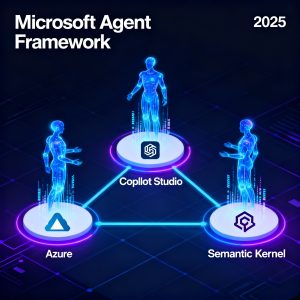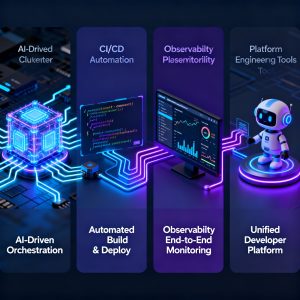The tech ecosystem evolves every year, but 2025 stands out as a period where practicality finally outweighs hype. Developers who once rushed to adopt every new framework are now realizing that sustainable growth lies in mastering fundamentals, integrating AI seamlessly, and choosing the right tools for real-world demands.
For today’s full-stack developers, the focus isn’t just on chasing the next big trend — it’s about understanding what truly moves the needle in building scalable, secure, and high-performing applications.
AI-Driven Development Is Here to Stay
After years of skepticism, artificial intelligence has cemented its place as a core part of modern development workflows. Tools like GitHub Copilot, Google’s Jules, and Claude are redefining how code is written, debugged, and reviewed. Developers can now automate boilerplate generation, receive architecture-level recommendations, and even request voice summaries of repository changes.
AI tools aren’t replacing developers; they’re amplifying productivity. By outsourcing repetitive coding tasks to intelligent assistants, developers can prioritize problem-solving, architectural planning, and code quality.
Reality Check:
In 2025, learning to collaborate with AI tools is no longer optional. Those who resist will find themselves at a strategic disadvantage.
React Still Dominates, but the Ecosystem Is Maturing
React remains the foundation of front-end development, though its dominance has slightly declined. Reports show usage dipping from 76% in 2022 to around 70% in 2024. However, this doesn’t signal React’s downfall — it highlights a maturing ecosystem moving toward stability.
The rise of React Server Components marks a major shift. By blending server and client rendering logic, developers can eliminate redundant fetch cycles, reducing complexity and bolstering performance.
Meanwhile, frameworks like Astro are gaining traction for content-heavy sites, introducing modular “islands architecture” for greater speed and control.
Reality Check:
React isn’t going anywhere. But developers need to adapt to its new paradigms rather than chasing the next “React killer.”
Next.js Becomes the Full-Stack Core
What began as React’s server-side rendering companion has evolved into the full-stack backbone of web development. Next.js 15 supports hybrid rendering — blending SSR, SSG, and edge functions — along with seamless backend integrations through API routes.
Next.js’ App Router and Server Actions empower developers to centralize logic, handle APIs, and optimize front-end rendering in one cohesive codebase. It’s a one-stop ecosystem for fast, scalable, enterprise-grade apps.
Reality Check:
Next.js is “eating the web.” For most production use cases in 2025, it’s a complete end-to-end solution that merges performance, server integration, and developer convenience.
The Backend Revolution: Serverless and Simplified
The backend landscape is undergoing a quiet revolution. Serverless architectures have moved from novelty to necessity, allowing developers to deploy functions without managing servers. Platforms like AWS Lambda, Google Cloud Functions, and Cloud Run now support on‑demand scaling and simplified maintenance.
This approach transforms how developers design systems—scaling automatically and requiring zero manual configuration. Combined with modern runtimes like Python’s FastAPI or Go, backend performance and scalability have reached new levels of accessibility.
Reality Check:
Traditional server management is fading fast. The ability to write efficient, event-driven functions is now one of the most valuable backend skills in a full-stack developer’s toolkit.
The 2025 Full-Stack Stack: What Developers Are Actually Using
Today’s developers are balancing speed, performance, and maintainability. Here’s what defines a pragmatic 2025 stack:
- Frontend: TypeScript with React and Next.js for most applications; Astro for content-heavy sites; Svelte for experimental prototypes.
- Backend: Node.js with Express (for APIs), Python with FastAPI (for AI and data tasks), and Serverless functions for scalable microservices.
- Databases: MySQL for core relational workloads, PostgreSQL for JSON operations, Redis for caching, and Supabase for quick MVPs.
- Deployment: Vercel for Next.js, Railway for backend processes, and AWS or Google Cloud for large-scale containers and event-driven workflows.
- AI Tools: GitHub Copilot for code assistance, Claude for architecture reviews, and Copilot Chat for documentation and refactoring recommendations.
Reality Check:
Modern development isn’t about mastering everything—it’s about knowing how to connect these tools efficiently to solve real-world problems.
Skills That Matter Most in 2025
Modern engineering teams now favor versatile professionals who understand the entire product lifecycle. The must-have skills for 2025 reflect this shift toward cross-disciplinary expertise :
- Full-Stack Awareness: Know how frontends, backends, and databases connect — even if you specialize in one layer.
- TypeScript Mastery: Becoming fluent in static typing reduces runtime errors and boosts maintainability.
- AI Collaboration: Learn where AI tools help accelerate work and when human oversight is essential.
- Security Knowledge: With the dawn of quantum computing, understanding encryption, authentication, and secure deployment practices is critical.
- Cloud and DevOps Fundamentals: Proficiency in CI/CD pipelines and container tools like Docker and Kubernetes ensures smooth delivery at scale.
Reality Check:
Technical depth is good—but versatility and adaptability are indispensable.
Tech Trends Worth Ignoring (For Now)
Not every shiny trend deserves attention. In 2025, certain technologies remain overhyped relative to their practical adoption:
- Blockchain and Web3: Still seeking mainstream use cases beyond financial speculation.
- Constant Framework Churn: Learning every new frontend tool wastes valuable time — wait for stable, widely adopted versions before switching.
- No-Code Platforms: Ideal for prototypes, but not replacements for robust engineering practices.
Reality Check:
Ignore trends that don’t align with your project goals. Focus on scalable, maintainable solutions that deliver user value fast.
Areas Still on the Horizon
Some innovations are poised to shape the future but remain in their early adoption phase:
- Bun vs Node.js: Bun’s performance is notable, but ecosystem maturity remains a hurdle.
- WebAssembly: Progressing slowly, but will gain traction for compute-heavy browser tasks.
- Tauri Framework: An exciting contender for efficient desktop apps built with web technologies.
Reality Check:
Stay curious, but choose tools that align with your workflow—not those leading the hype cycle.
Predictions for the Rest of 2025
- AI coding assistants will become as essential as IDEs.
- React’s Server Components will dominate front-end workflows.
- Serverless computing will become the default for new startups.
- TypeScript adoption will surpass 80% across enterprise ecosystems.
Reality Check:
Developers who embrace these trends strategically—without losing sight of fundamentals—will thrive in 2025’s fast-moving landscape.
The Real Developer Mindset
At its core, success in full-stack development isn’t about chasing every technology. It’s about delivering value quickly, maintaining code quality, and adapting when priorities change.
The best developers aren’t those fluent in dozens of frameworks, but those who:
- Choose the right tools for the job;
- Ship features reliably and efficiently;
- Understand the technology stack end-to-end;
- Continue learning as technology evolves.
Read more such articles from our Newsletter here.



